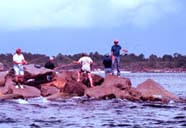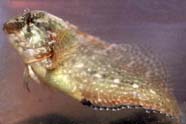| |
Glossary of Coral Reef Terminology - J
J curve - a J-shaped growth curve that depicts exponential growth |
Jaccard distance - a statistic which measures dissimilarity between sample sets. It is obtained by dividing the difference of the sizes of the union and the intersection of two sets by the size of the union, or, simpler, by subtracting the Jaccard coefficient from 1 |
Jaccard index - a statistic used for comparing the similarity and diversity of sample sets; also known as the Jaccard similarity coefficient |

A pack of crevalle jacks swimming over a Caribbean reef. Note the characteristic line of bony scutes along the lateral surface. (Photo: Anthony.R. Picciolo, Ph.D./NOAA)
|
Jack - any species of bony fishes in the family Carangidae (which also includes the pompanos). Jacks are cosmopolitan in warm and temperate marine waters, some even venturing into brackish and fresh water. As a group, they are swift and strong predators. Typically, jacks have a series of lateral scutes along each side of the caudal peduncle. In some species, these scutes extend along the lateral line. Some are important game and food fishes |
Jaspaquinol - an antiinflammatory drug derived from the marine sponge Jaspis splendens |
Java - a programming language created by Sun Microsystems which allows the user to create programs which run well in a networked environment (such as the World Wide Web). Java programs are commonly called "applets" and can be used to add anything from calculators to animated images to web sites |
jawfish - species of small bony fishes belonging to the family Opistognathidae. Jawfishes inhabit sandy, rubble-strewn areas on the reefs where they dig burrows into which they retreat when danger threatens. They hover over their burrows and feed on small animals that swim or drift by. The entrances to their burrows are lined with small pebbles or coral rubble and they are continually "grooming" the burrow by shoveling out mouthfuls of sand. They frequently raid neighboring jawfish's burrows to steal pebbles. Males are mouth breeders, carrying fertilized eggs in their mouths until they hatch |
Jellyfish Lake - an isolated marine lake in the Rock Islands of Palau's southern lagoon that provides habitat for millions of “stingless” jellyfish. The 30 meter-deep Jellyfish Lake is completely isolated from the ocean, except for marine waters that enter via the porous limestone of the island. The jellyfish are not really stingless, but the sting is mild and often undetectable. In the distant past, the lake had an outlet to the lagoon, but it was closed off, isolating the high jellyfish population which thrived upon algae. At night, the jellyfish descend into an anoxic layer of hydrogen sulfide which is found close to the bottom, below 15-20 meters.Two species of jellyfish inhabit the lake: the golden or spotted jelly (Mastigias papua)and the less common moon jelly (Aurelia sp). Golden jellies, like shallow water corals, harbor microscopic algae in their tissues, which through the process of photosynthesis, provide energy for themselves and the jellyfish by converting chlorophyll into sugars. They are also carnivorous, capturing zooplankton with stinging cells located on their oral arms. The moon jellies are carnivorous. Five separate subspecies of Mastigias inhabit each of five different marine lakes in Palau |
jetsam - objects that have been thrown overboard in order to lighten a ship when it is in trouble |

A jetty protecting the shore line. (Photo: NOAA)
|
jetty - a structure extending into the ocean to influence the current or tide in order to protect harbors, shores, and banks |
Johnson-Sea-Link (JSL) Submersible - the Johnson-Sea-Link (JSL) I and II submersibles are owned and operated bythe Harbor Branch Oceanographic Institution. At 23.6 ft long, 10.9 ft high and 8.3 ft wide, these highly maneuverable submersibles can dive to a depth of 3,000 ft and travel at a maximum speed of one knot |
joint - the place where two articulating segments meet |
joint probability - the probability of two or more things occurring together |
Jordan's Rule - In general, closely related species do not have identical ranges, but often their ranges are not very far apart. They are usually adjacent but separated by some kind of a geographic barrier, such as a mountain, desert, or river. A second Jordan's Rule is: fishes develop more vertebrae in cold environments than in warm ones |
JPEG (Joint Photographic Experts Group) - the original name of the committee that wrote the standard. It is a lossy compression technique for color images. Although it can reduce files sizes to about 5% of their normal size, some detail is lost in the compression |
jugostegalia - a basket-like structure formed midventrally by overlapping branchiostegals in some families of eels |

Blennies have their pelvic fins in the jugular position, anterior to the pectoral fins. (Photo: South Florida Water Management District)
|
jugular - pertaining to the throat area |
junior homonym - in taxonomy, the younger, or most recently established taxonomic name |
junior synonym - in taxonomy, the younger name of two synonyms |
junk DNA - a term used to describe the excess DNA which is present in the genome beyond that required to encode proteins. The term is misleading since these regions are likely to be involved in gene regulation, and other not yet known functions; a non-coding sequence of DNA; an intron |
juvenile - a young animal that has not reached sexual maturity |
juxtaposed - placed near together |
|
|
|
|

